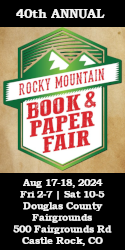In Praise of Follies
(originally published in the Sept/Oct 2003 issue of Book Source Magazine)
The Victorian period, especially in England, was a hotbed for architectural follies. In an article on Victorian follies in the July 2003 issue of The Antiquer, Adele Kenny notes several definitions, including the Oxford English Dictionary’s kindly and understated — “a popular name for any costly structure considered to have shown folly in the builder.” Chambers goes a bit further with “a great useless structure, or one left unfinished, having begun without a reckoning of the cost” and the Oxford Companion to Gardens, in case we still don’t get it, says architectural follies are “characterized by a certain excess in terms of eccentricity, cost or conspicuous inutility.” I think the two words “conspicuous inutility” sum it up best, but say what you will a lot of us love them all the same.
Architectural follies began to appear in England during the 18th century but it wasn’t until the early industrial period of the 19th century that wealthy new owners of landed estates were able to indulge their fantasies on a grand scale. The construction of great stone towers of various shapes and sizes, faux Greek Parthenons, private churches or chapels, obelisks and other monuments to impracticality (often left unfinished so as to suggest ruins from a distant past) in many ways represented a subconscious rebellion against the utilitarianism of the factory age — and were often built by the industrialists themselves.
An inquiry at your bookstore or a search of any of the on-line antiquarian book databases should turn up a variety of books on the subject and there are several websites that provide text and images describing many of the more interesting sites in Britain and elsewhere.
Modern day follies have morphed into a variety of types, shapes and sizes, some with a vague connection to the architectural follies of the past, some not. Purists may argue the term should not be expanded to cover the newer forms but that’s their problem, not mine.
In recent years the lawn and garden sections of Home Depot, Lowes or any of the big home improvement stores have been stocking up on garden pond supplies for city and suburban homeowners with dreams of creating watery oases or artificial mountain streams in their backyards. Many of the pond kits are modest in size and not much more expensive than an antique lawn jockey, a few garden gnomes, a fake windmill or some other form of garden clutter. It’s when you get into the big league that things can really get out of hand. Out of curiosity I recently attended a meeting of a regional garden pond club held at the home of a couple who have created a koi (ornamental Japanese carp) pond large and deep enough to swim in and with a water filtration system that many third world villages would envy. The waterfall and artificial mountain stream were constructed with boulders weighing — I would guess — up to a half ton each and the surrounding area has been professionally landscaped. The koi themselves (about 20) are up to two feet in length, weigh 15 to 20 pounds or more, and are of every exotic color prized by koi fanciers — of which I am not one. I do, however, respect the knowledge, dedication and hard work that went into creating this watery folly. A philistine may carp (no pun intended originally — but what the hell) about the “conspicuous inutility” of a pond used to raise fish costing 25 to 50 times as much as the finest Alaskan salmon, but philistines are always carping about artificiality, artifice or art. Besides the obvious linguistic connection, using basic materials to create images from nature, memory or the imagination is what these words are all about.
I suppose one could make the case that extreme gardening projects sometimes transform themselves into yet another class of follies. An unfinished Greek temple, an arch, a stone bridge to nowhere, or an Irish tower would be a bear of a project to begin with, but once constructed deliberate neglect only enhances the appearance of false antiquity. Extensive gardens, however, are easy to start but extraordinarily difficult to maintain. I paraphrase from a likely story told by the author of a gardening book I read not long ago. The vicar leaning over the gate says “Hello George, you and the Almighty have made a wonderful job tending the garden” to which George replies “Thank you vicar, but you should have seen it when He was doing it all by himself.”
Our own gardens, which most of my neighbors must think are a bit much and over the top, now number more than 18. Our folly includes two large vegetable gardens and at least 16 ornamental beds of varying size with an ever-increasing number of flowering annuals and perennials, including both Asiatic and Oriental hybrid lilies, dahlias in every size and color, mums hardy enough to survive Alaskan winters, a variety of flowering shrubs, begonias (rex, wax and tuberous), the usual assortment of spring bulbs, and many other species and varieties that would probably bore all but the most dedicated gardening fanatic. And I almost forgot to mention a small pond (with a fountain and waterfall), home to two gold fish and an undetermined number of frogs — all named Billy Joel.
The work is hard and sometimes a bit discouraging because of local infestations of Eastern Whitetail deer — insects and plant disease, by contrast, cause little problem. Interestingly, farmers nearby have less of a deer problem because New York State hunting regulations now give farmers special permits to hunt deer (especially does) throughout the year. By any measure, our project is a horticultural folly making absolutely no economic sense and hanging over everything is the certain knowledge that when we're removed from the scene, everything will soon become what it was when the “Almighty…was doing it all by himself.”
Some folks might and undoubtedly do argue that creating a work of the imagination from plant, soil and rock is a foolish idea from the start because unlike works of imitation or imagination created from pigments, oil, bristle, and canvas, our gardens will eventually revert to an uncultivated and tangled mass of vegetation — nature’s way of mocking our floral and botanical hubris.
An often-romanticized institution close to becoming a modern folly is the traditional antiquarian bookshop specializing in relatively inexpensive used and out-of-print books. Nearly everyone knows urban bookstores have fallen victim to high rents and a declining customer base as the more highly educated middle class continues its forty year or so migration from the cities to the suburbs and beyond. Visitors to secondhand bookshops hope to browse large inventories, but the high cost of retail premises combined with generally slow turnover, means open shops have become a luxury that fewer booksellers are willing to underwrite — especially in this age of catalogue and Internet sales.
Nonetheless there are bibliophiles whose ideas of a literary-business nirvana derive from real or fancied memories of London’s Charing Cross Road, New York City’s Book Row, or the imagination of Christopher Morley. Incidentally, I happen to know two people who, confronting general public apathy, have cast sound business sense aside and continue to operate wonderful antiquarian bookshops, drawing heavily from their own resources to do so. Oddly enough, these modern biblio-philanthropists are apparently undaunted by the reality that their Parnassian gardens of bookish delights continue to exist for a market that is no longer there. (Note: since this first appeared in 2003, the two previously mentioned bookshops have closed).

























